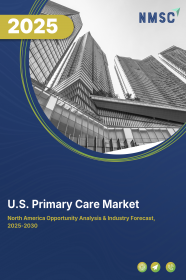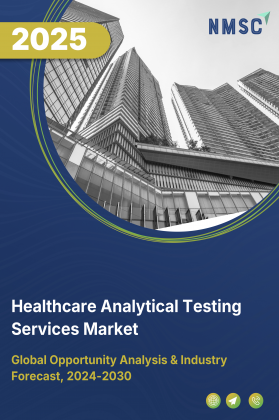
U.S. Primary Care Market by Provider Type, (Independent Practices, Hospital/Health System PCPs, Large Physician Groups, Value-Based Networks, Direct/Concierge Care, Retail Clinics, Payer-Owned Clinics, Employer Clinics, Virtual-First PCPs, Community Clinics), by Clinical Offering, (Preventive Care, Acute Care, Chronic Care, Behavioral Health, Women’s And Pediatrics, Diagnostics And Labs, Care Coordination, Other Services) – The U.S. Opportunity Analysis and Industry Forecast 2025-2030
U.S Primary Care Market Overview
The U.S. Primary Care Market size was valued at USD XXX billion in 2024 and is predicted to reach USD XXX billion by 2030 with a CAGR of XY% from 2025-2030.
The U.S. primary care market is an integral part of the healthcare system, comprising a wide variety of services that are accessible for people across all age groups. It comprises services provided by general practitioners, family physicians, pediatricians, and others who major in preventive care, diagnosis and treatment of acute and chronic illnesses, and the education of patients. The market setting includes private practices, clinics, community health centers, and integrated health systems.
Primary care or preventive care is a very crucial part of the healthcare system. It provides preventive care to manage chronic diseases by coordinating patient care with the first point of contact of patients. Primary care plays a vital role in enhancing health outcomes, promoting patients' satisfaction, and lowering healthcare costs by laying more emphasis on early intervention and follow-up care.
Market Dynamics and Trends
The increase in chronic diseases such as diabetes, cardiovascular diseases, and respiratory ailments in the U.S. propels the demand for the primary care diagnostics. These services include involves periodic monitoring, medication management, patient education, and preventive measures.
According to recent report published by the U.S. Department of Health and Human Services, approximately 129 million persons in the U.S. had at least one of the major chronic diseases such as heart disease, cancer, diabetes, obesity, or hypertension. Further, five of the ten leading causes of death in the U.S. are linked to such preventable and treatable chronic diseases. Such an increase in the number of chronic diseases will actually raise the U.S. primary care market demand for comprehensive and accessible care in managing these diseases for improved outcomes in health.
Moreover, the primary care market is driven by the rising geriatric population along with increasing number of chronic conditions including CVD and diabetes. This in turn drives the demand for interactive patient care, regular monitoring, and proactive healthcare measures including primary care services.
According to the latest report published by the U.S. Census Bureau, the aging populations is increasing rapidly in U.S., people above 65 years and older is expected to rise to 82 million in 2050 from 58 million in 2022. This defines a positive demographic change, coupled with a growing demand for sophisticated, adequate healthcare solutions since primary healthcare plays an extensive role in managing chronic conditions and health promotion among individuals.
Furthermore, in the U.S., government initiatives and investments are driving the U.S. primary care market growth by enhancing healthcare infrastructure, supporting research, and fostering innovation. These efforts improve the quality and accessibility of primary care services, streamline healthcare delivery, and promote preventive care.
For instance, in June 2024, The National Institutes of Health (NIH) launched a USD 30 million pilot program to test the feasibility of establishing a national primary care research network. The initiative aims to enhance primary care by integrating diverse data sources, improving patient outcomes, and addressing healthcare disparities in the U.S. However, the high costs of healthcare services and the challenges associated with reimbursement significantly restraint the primary care practices in the U.S.
On the contrary, adoption of integrated care models such as patient-centered medical homes (PCMHs) and accountable care organizations (ACOs) is anticipated to create ample opportunities for the growth of the market in the coming years. These models are designed to enhance coordinated care delivery by facilitating collaboration among primary care providers, specialists, and other healthcare professionals to notably improve health outcomes and elevate the overall quality of preventive healthcare services available to patients.
Market Segmentations and Scope of the Study
The U.S. primary care market report is segmented on the basis of primary care services, service providers, revenue models, patient demographics, and mode of consultation. On the basis of primary care services, the market is divided into preventive care, diagnosis, management of chronic diseases management, treatment of acute illness, and others. On the basis of service provider, the market is classified into independent, institutions, payer-owned primary care providers, retailers and ancillary providers.
Based on revenue models, the market is bifurcated into Fee-for-Service and Fee-for-Value/Value-Based Care (VBC). Based on patient demographics, the market is categorized into pediatrics, adults, and geriatrics. On the basis of mode of consultation, the market is segmented into in-person medical care and digital and virtual healthcare services.
Competitive Landscape
The U.S. primary care industry comprises of various key players such as One Medical, Oak Street Health, Carbon Health, Aledade, Marathon Health, Village Medical, Crossover Health, ChenMed, Pearl Health, Apree Health (Vera Whole Health), Accompany Health, Firefly Health, Hint Health, MDVIP, Plum Health DPC, and others. These companies are adopting strategy such as business expansion to remain dominant in the market.
For instance, in November 2023, Oak Street Health, a subsidiary of CVS Health expanded its healthcare services in Lowa, U.S., by opening a new primary care center. The center was established with the aim to reduce hospital admissions, readmission rates, and emergency visit by incorporating behavioral health support and addresses social determinants of health, accessible through in-center, in-home, and telehealth appointments, supported by a 24/7 patient hotline.
Key Benefits
-
The report provides quantitative analysis and estimations of the U.S. primary care market from 2025 to 2030, which assists in identifying the prevailing market opportunities.
-
The study comprises a deep dive analysis of the current and future U.S. primary care market trends to depict prevalent investment pockets in the market.
-
Information related to key drivers, restraints, and opportunities and their impact on the U.S. primary care market is provided in the report.
-
Competitive analysis of the players, along with their U.S. primary care market share is provided in the report.
-
SWOT analysis and Porters Five Forces model is elaborated in the study.
-
Value chain analysis in the market study provides a clear picture of roles of stakeholders.
U.S. Primary Care Market Key Segments
By Provider Type
-
Independent Practices
-
Hospital/Health System PCPs
-
Large Physician Groups
-
Value-Based Networks
-
Direct/Concierge Care
-
Retail Clinics
-
Payer-Owned Clinics
-
Employer Clinics
-
Virtual-First PCPs
-
Community Clinics
By Clinical Offering
-
Preventive Care
-
Acute Care
-
Chronic Care
-
Behavioral Health
-
Women’s And Pediatrics
-
Diagnostics And Labs
-
Care Coordination
-
Other Services
By Payment Model
-
Fee-for-Service
-
Value-Based / Capitation
-
Direct Patient Subscription
-
Employer-Direct Contracting
By Mode Of Consultation
-
In-Person
-
Virtual
-
Hybrid
By Patient Demographics (age)
-
Pediatrics (0-18)
-
Adults (19-64)
-
Geriatrics (65+)
Key Players
-
One Medical
-
Oak Street Health
-
Carbon Health
-
Aledade
-
Marathon Health
-
Village Medical
-
Crossover Health
-
ChenMed
-
Pearl Health
-
Apree Health (Vera Whole Health)
-
Accompany Health
-
Firefly Health
-
Hint Health
-
MDVIP
-
Plum Health DPC
Report Scope and Segmentation
|
Parameters |
Details |
|
Market Size in 2024 |
USD XXX Billion |
|
Revenue Forecast in 2030 |
USD XXX Billion |
|
Growth Rate |
CAGR of XY% from 2025 to 2030 |
|
Analysis Period |
2024–2030 |
|
Base Year Considered |
2024 |
|
Forecast Period |
2025–2030 |
|
Market Size Estimation |
Billion (USD) |
|
Growth Factors |
|
|
Companies Profiled |
15 |
|
Market Share |
Available for 15 companies |
|
Customization Scope |
Free customization (equivalent up to 80 working hours of analysts) after purchase. Addition or alteration to country, regional, and segment scope. |
|
Pricing and Purchase Options |
Avail customized purchase options to meet your exact research needs. |

















 Speak to Our Analyst
Speak to Our Analyst

























